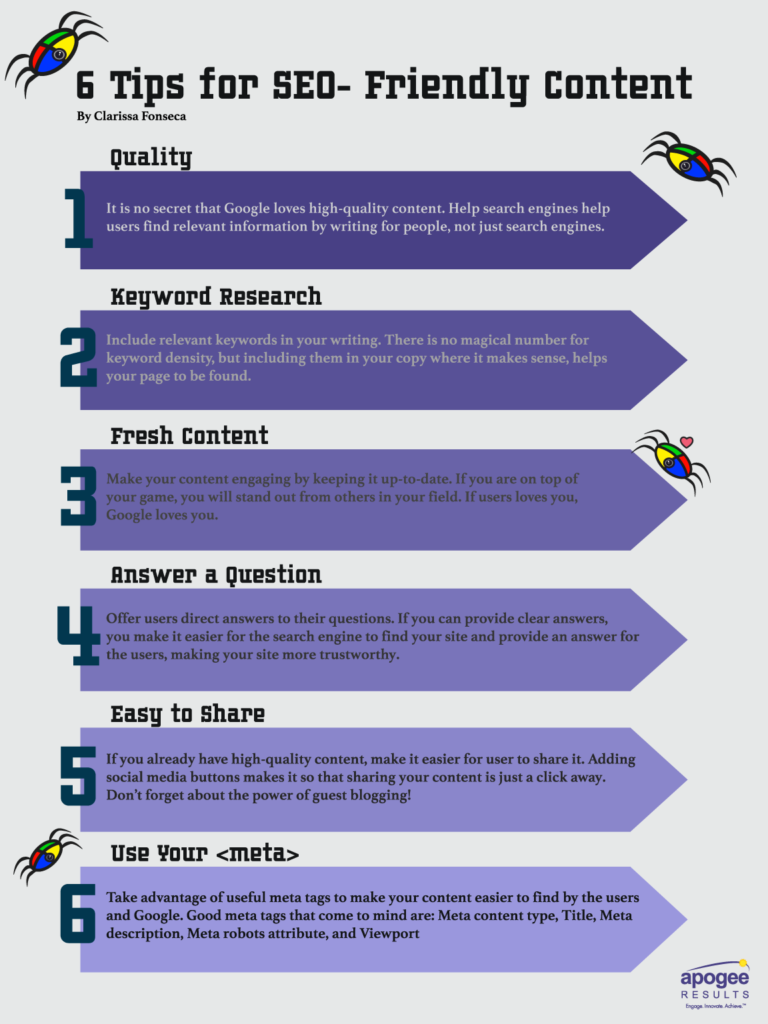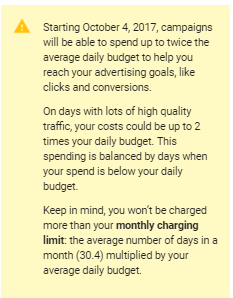by Apogee Results | Nov 6, 2017
In latest years, Google has emphasized the importance high-quality content. Google has published a couple of guidelines to help guide developers to write better documentation. While that might be a good way to get some clues, let’s make things simple and dive into a short infographic to help you write better SEO-friendly content!

6 Tips to write better content
by Apogee Results | Oct 4, 2017
 The latest notice in a series of troubling announcements that form a trend of control over our AdWords accounts being wrested away in favor of automation popped up in our MCC today.
The latest notice in a series of troubling announcements that form a trend of control over our AdWords accounts being wrested away in favor of automation popped up in our MCC today.

Before, AdWords could potentially spend up to 20% past your daily budget cap (traditionally set by that magic monthly budget divided by 30.4) based on the amount of available traffic on a given day. Now, depending on the criteria the system bases “high quality traffic” on, your daily budget is effectively moot (granted, you should theoretically never be charged more than the defined monthly limit – 30.4 x your average daily budget, otherwise you’ll be issued an overdelivery credit per AdWords’ documentation.
In theory, this should be great – capturing all of that valuable traffic out there while still staying within the constraints of a monthly budget is a no-brainer. In practice, this has a high potential of going poorly. Suppose you’re a small business, or otherwise don’t have a strictly defined monthly budget (perhaps you’re testing a specific initiative outside your ordinary ad spend, or you’re just starting to dip your toes into the AdWords ecosystem) , or you’re in a highly saturated, high competition vertical – hopefully, the overdelivery has a great ROI for you and therefore justifies the practice. Otherwise, even the overdelivery credit you get can become a potentially futile case of throwing good money after bad. If overdelivery is as functional as Smart Goals or Optimized Ad Rotation (the system heavily favors older ads, even with lower conversion rates & engagement), this spells trouble for account performance, not to mention effectively pacing budgets throughout the month. At very least, the new AdWords overdelivery policy merits heavy observation until we can get a collective sense of how well it functions.
In order for automation to be effective, it must be introduced with clearly defined strategy & rules in place, along with a solid foundation. When automated strategies are effective, they are a boon to ROI – unfortunately, the relentless creep towards automation in the AdWords platform has yet to provide stable, dependable success. Even industry leading automation platforms like Marin and Kenshoo can quickly lead to mediocre (at best) results in a case of Garbage In, Garbage Out.
Rather than being worried about automation putting me out of a job, I’m optimistic – now, more than ever, successful pay per click efforts will need experienced human eyes on them in order to drive the best possible results.
To ensure you’re getting the best ROI from your paid media campaigns, schedule a comprehensive audit.
by Apogee Results | Aug 28, 2017
OK, Google: What are the top five ways digital marketers can prepare for the voice search takeover?
For years now one of the trendiest, and simultaneously most inconclusive, topics among digital marketers has been the ground-breaking shift from traditional to voice search. With mobile usage statistics continually rising, this is not anticipated to be one of those changes that gets lost in the minutiae (even though we may like to pretend that no change does). Though few of us in marketing have felt the ground rumble just yet – there is a reason we have been trying to stay ahead of this shift. So, what can digital marketers do to stay ahead of the transition to voice search – this ominous “voice search takeover”? Will there even be a noticeable change from the marketer-side?
At Google’s I/O conference in May, AI was the primary theme. No surprise there—with Siri, Google Assistant, Amazon Fire, soon to be Google Lens, and other personal travel-sized iRobots running around, AI is now and will continue to be a buzzword. Google is no exception to that rule. A parallel focal point of the keynote (which, if you missed it is summed up nicely here by Forbes) was the huge emphasis on Google Assistant becoming more conversational. Google’s Scott Huffman said that now over 70% of Google Assistant requests are in natural language and not in traditional keyword lingo.

This means that increasingly (assuming more people hop on board with robot assistants, which are currently trending up and to the right) searches will be more grammatically correct, longer-tailed, and semantically driven. Maybe. All the on-page SEO and content people out there are already popping champagne bottles over the fact that they won’t have to try and naturally incorporate some high-volume, low-competition jargon six times in one paragraph of content.
But hold on…
Since Google’s release of the Hummingbird update in 2013, the idea of semantic-search has already been a priority for content-driven folks. So, is this change really going to affect what we are doing?
It’s becoming clear (better late than never) that this radical shift to voice may not be radical if we continue to focus on the right things as marketers. We can hypothesize all day that the transition to voice search will bring local SEO to the forefront, that queries themselves will be longer-tailed and more diverse, or that voice search is going to change {insert your favorite hypothesis here!} about digital marketing. But realistically, we won’t know until we get there – the only data we have is retroactive. Disappointingly (or not), our task as marketers is to make the absolute best using the data that we have. For now, much of that is laying a solid foundation both technically on-site and in the overall marketing methodologies we employ.
Here is a list of the five absolute best ways digital marketers can prepare for the Voice Search Takeover:
- Good UX is key
This has a million sub-parts but has been a Google priority since day one. Here are some of the ways to ensure that your site is performing for users:
· Use structured data markup – since it is still grossly underutilized, having good markup makes it easier for sites to rise to the top of the SERP’s and be featured as rich snippets. Though this part is often not considered as UX (because it is not technically on-site), it is still a part of the user journey that needs to be simplified and improved as much as possible.
· Implement a tag management system like GTM now (migrating is not going to get easier down the road – start now and get ahead). Tag management will reduce page load speed making your site faster, easier to navigate, and overall more user-friendly. As an added bonus, tag management simplifies life for marketers and developers alike. Win, win!
· Use a secure site protocol – though this has been a known ranking factor since 2014, most sites still haven’t made the shift to https://. Besides being a direct-ranking factor, having a secure site also impacts user trust which is arguably just as (or more) important for long-term website success.
· Continuously improve site speed.
· Improve mobile sites – The rule here is quit making them if you are going to make them poorly! With the recent mobile-first index update, improving and optimizing mobile sites should be a number one business priority.
2) Content is king
With voice searches potentially lengthening search queries overall -minimizing marketers’ ability to as successfully keyword inflate content- actually good content needs to be a priority. Since day one, Google has been telling us to provide relevant, user-friendly content. Now it makes more sense than ever to do that.
3) Clean Your Data
Though Analytics may not directly affect your SERP rankings, it (hopefully) affects overall business decisions and should ALWAYS be a primary focus for marketers and businesses alike. Make sure that the reports you are generating are providing good, high-integrity data or the decisions that you are making may have a fundamentally unsound basis. Without clean data, how can we ever know if what we are doing is working?! If you haven’t set up Analytics yet, or done an audit recently, Avinash Kaushik is an amazing Analytics resource to learn from or you can request a free Analytics audit here:
4) Minimize segmentation in your marketing approach
I want to put this one chronologically first because it is arguably the number one sin of most marketers – both for in-house and agency folks alike. We humans like to think in organized, neat, compartmentalized buckets. To stay ahead and to really be well-equipped for the “Voice takeover” or ANY other changes in the digital realm moving forward, the trick is to think holistically about the user-journey and what the business needs to do to accommodate continuous improvement of that journey (cross-departmental communication required–gasp!).
5. Refine your overall marketing methodology
At its core, marketing is the practice of understanding the business in such a way that you can articulate its value to customers and potential customers effectively. This means fully understanding the customer journey and refining your marketing and business strategies iteratively to accommodate shifting customer priorities.
The challenge here is that good marketing takes one step further than just “good sales” or “good account management”. For successful sales and account management it is imperative to understand your client’s needs. Good marketing, however, requires not only that you understand your client well, but that you understand your client’s customer well. This one degree of separation, though it seems small, is often the reason why marketers (even great ones!) can fall flat. Customer-centric marketing is critical to getting ahead and staying ahead, independent of industry changes.
Good, technically sound, user-friendly sites with great content are not going to be cataclysmically affected if/when the great Voice Takeover does in fact occur. Build a sturdy foundation now, and we will all make it through hunky dory to the other side.
by Apogee Results | Aug 14, 2017
It’s ‘the End of Digital Advertising as We Know It’ – and I feel fine.
Well, this is it – it’s the end of digital advertising as we know it. And, quite frankly, I feel just fine about it. Data suggests Procter & Gamble and Unilever are pulling back on digital ad spend – MediaRadar estimates a 41% drop for P&G, and a 59% drop for Unilever year over year. This should come as no surprise following P&G’s public statements on the need for the industry to ‘grow up’ in terms of transparency in contracts, work fulfillment & reporting in the digital advertising space on the heels of programmatic display ads appearing alongside sensitive and otherwise undesirable content and sites. As more and more of the titans of the industry look to scale back their digital marketing budgets and make significant shifts in overall marketing strategy, a deluge of alarmist blog posts about the “end of digital advertising” is gathering on the horizon.
Despite the fact that blog writers have been proclaiming the end of digital marketing in one form or another (one particular favorite is the “death of SEO” articles that crop up after every significant algorithm update Google makes) ever since the very beginnings of the industry, digital marketing is alive and well – and, with transparent, proactive management, has more potential than ever before.
One of P&G’s primary pain points is the recent discovery that the contract in place with one of their agencies did not strictly stipulate how funds were allowed to be used, opening the door for the agency in question to make profit off of money allocated for media spend in addition to their management fees. As P&G dug in further, it turned out that the management fees were not sufficient to cover the agency’s costs. Transparency and clearly defined engagements in terms of contracts and scope of work are fundamental for satisfaction and success in the digital marketing space. The need for clear, open channels of communication is key. Both agencies and their clients should follow P&G’s lead and re-examine contracts and relationships in order to ensure a mutually beneficial foundation is in place with clearly defined contracts, scopes of work, open communication and reporting. Without a clear picture of not only where marketing budgets are being spent, but also what return on investment is being driven (primarily on ad spend and media buys and, on a higher level, including agency fees as well), it is impossible to justify marketing investments and continued relationships on either side. Closely related to the issue of overall transparency is issues involving client access to accounts & data – ultimately, the more open agencies are with their methods and results, the better – not only does open access lead to better potential for collaboration between agencies and their clients to take campaign performance to the next level. Improved oversight helps to minimize campaign mis-steps and further assists in clarity of communication, as the abstruse concepts of digital marketing are clarified for clients in the process.
Programmatic Display advertising is a double-edged sword – on the one hand, managing a large swath of placements in real time gives agencies and businesses massive reach into highly targeted audiences. On the other hand, due to the nature of how the technology works, it is possible for advertisements to appear alongside undesirable content such as terror and hate group propaganda. While the ad networks are taking proactive steps to weed out such content and otherwise assist brands in protecting themselves, it is vital to closely monitor display campaigns of any size, particularly as they grow in scale. The good news is, by following branding guidelines, defining highly segmented target audiences, and closely monitoring placements, advertisers can not only protect brands, but also ensure effective ad spend in the process.
While larger brands like P&G and Unilever are reexamining their digital marketing strategies and are tightening their budgets in the process, it is nowhere near the ominous development for the digital marketing industry as a whole that some blogs will make it out to be. Rather, we should all take the time to ensure solid foundations of clearly defined relationships, scopes of work, transparency & access to data, and open communication between agencies and clients. On the fulfillment side, advertisers need to ensure their clients’ needs are not only being met, but also that their brands are being protected and treated with utmost care. While we urge agencies to operate at a high level of service & transparency, the onus is ultimately on the client side to ensure their marketing budgets are being put to effective use, and that they receive their due treatment with appropriately rendered services. One way to accomplish this is to receive a second opinion from a third party. Most digital agencies will do preliminary audits for free which can elucidate site weaknesses that your current marketing efforts may have missed and prioritize areas of spend moving forward.
–Post written by David Torres, PPC, CRO


 The latest notice in a series of
The latest notice in a series of 



